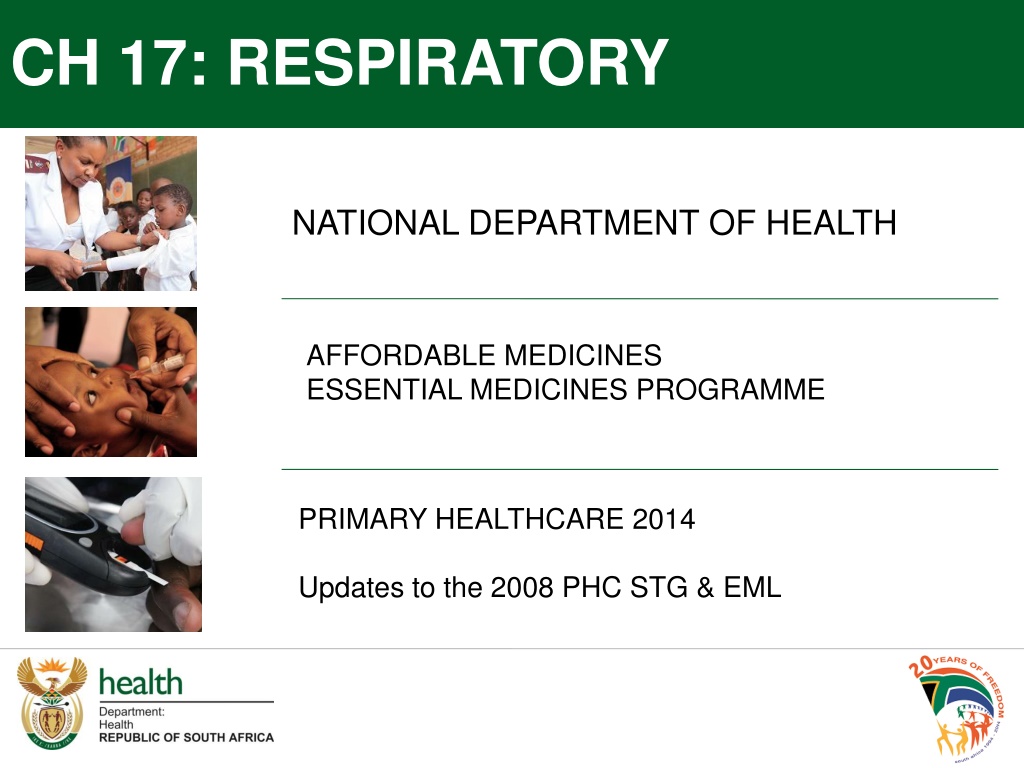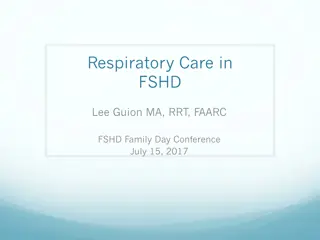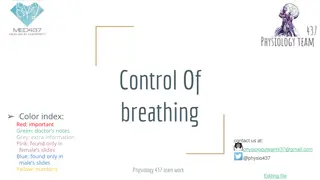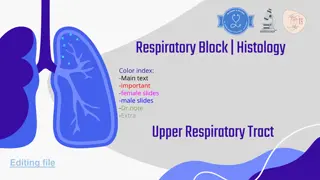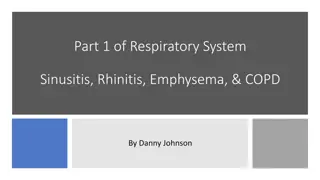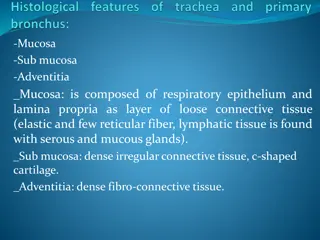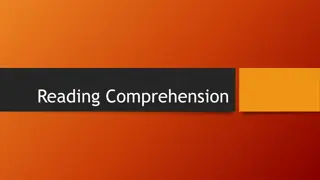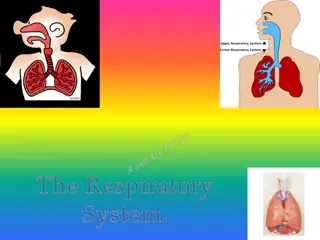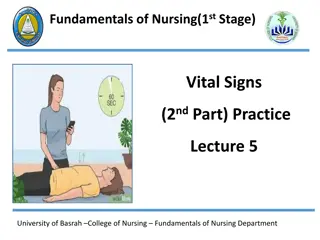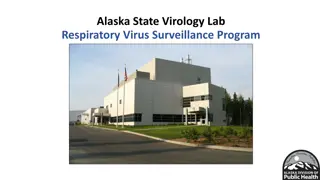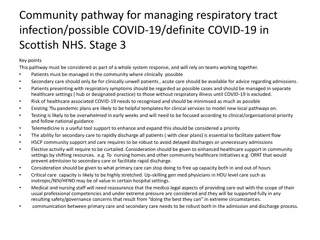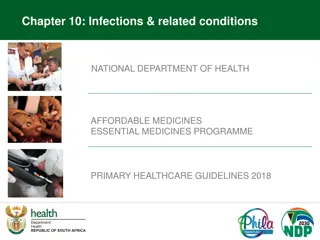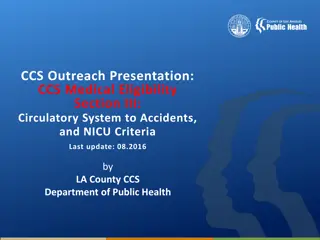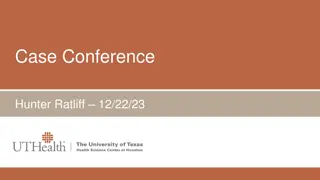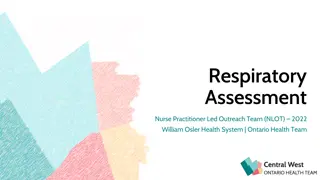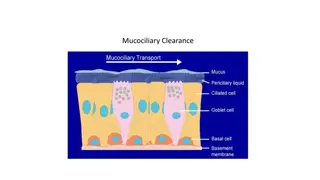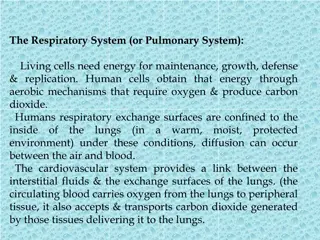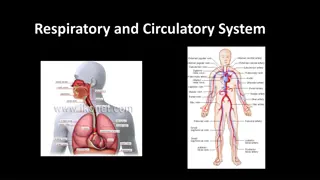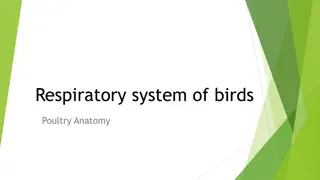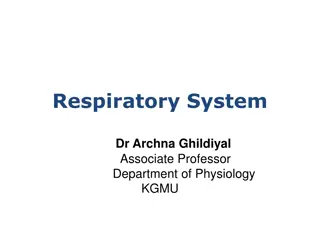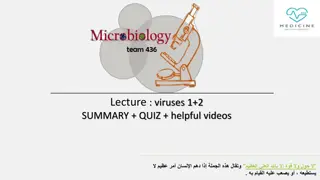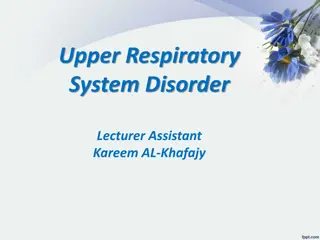Update on Respiratory Guidelines in Primary Healthcare, 2014
The respiratory guidelines in primary healthcare were updated in 2014 with changes in the approach to therapy and specific recommendations for acute asthma and COPD exacerbation cases in adults and children. Modifications include dosage adjustments for medications and the introduction of new sections addressing MDR-TB. Recommendations emphasize a syndromic approach to therapy and the use of spacers for managing acute episodes when nebulizers are unavailable.
Download Presentation

Please find below an Image/Link to download the presentation.
The content on the website is provided AS IS for your information and personal use only. It may not be sold, licensed, or shared on other websites without obtaining consent from the author. Download presentation by click this link. If you encounter any issues during the download, it is possible that the publisher has removed the file from their server.
E N D
Presentation Transcript
CH 17: RESPIRATORY NATIONAL DEPARTMENT OF HEALTH AFFORDABLE MEDICINES ESSENTIAL MEDICINES PROGRAMME PRIMARY HEALTHCARE 2014 Updates to the 2008 PHC STG & EML
CHAPTER LAYOUT Syndromic approach to therapy: Chapter layout according to presentation of the condition, rather than ATC (Anatomical Therapeutic Chemical Classification System). Deleted sections: Pneumocystis jiroveci pneumonia (PCP) in children - pneumonia STG guides diagnosis with referral of PCP to higher level of care. Common cold STG moved to ENT chapter. Amended sections: Pneumonia & TB separated into adult & children sections. New sections: MDR-TB STGs for adults and children. Ref 1 PRIMARY HEALTHCARE 2014 IMPLEMENTATION SLIDES: RESPIRATORY 2
17.1.1 ACUTE ASTHMA AND ACUTE EXACERBATION OF COPD Oxygen 40%: directions amended Salbutamol 0.5%, solution nebulisation: dose amended Aligned with Adult Hospital level STG, 2012 & Paediatric Hospital level STG, 2013. Level of Evidence: III Guidelines Ref 2 PRIMARY HEALTHCARE 2014 IMPLEMENTATION SLIDES: RESPIRATORY 3
17.1.1 ACUTE ASTHMA AND ACUTE EXACERBATION OF COPD If no nebuliser available Salbutamol, inhaler: directions for use amended Aligned with Section 17.1.2 Chronic asthma Use of a spacer and mask, recommended, if nebuliser is not available for managing acute episodes. Rationale: Administering salbutamol via a spacer is as effective as and cheaper than using a nebuliser. Level of Evidence: III Guidelines Ref 3 PRIMARY HEALTHCARE 2014 IMPLEMENTATION SLIDES: RESPIRATORY 4
17.1.1 ACUTE ASTHMA AND ACUTE EXACERBATION OF COPD Children with acute asthma Prednisone, oral: added Hydrocortisone , IV:amended Aligned with Paediatric Hospital level STG. Level of Evidence: III Guidelines Ref 4 PRIMARY HEALTHCARE 2014 IMPLEMENTATION SLIDES: RESPIRATORY 5
17.1.1 ACUTE ASTHMA AND ACUTE EXACERBATION OF COPD Adults with acute asthma or COPD Prednisone, oral: amended Hydrocortisone , IV:amended Aligned with Adult Hospital level STG. Level of Evidence: III Guidelines PRIMARY HEALTHCARE 2014 IMPLEMENTATION SLIDES: RESPIRATORY 6
17.1.2 CHRONIC ASTHMA ADULTS Leukotriene receptor antagonists: not added Leukotriene receptor antagonists are prescribed by sub-specialists at a hospital level. Level of Evidence: III Guidelines Theophylline: deleted LABA/ICS inhaler combination: added Efficacy & safety 1. LABA + ICS vs. ICS + theophylline: Cochrane review (2007) of 13 studies (n=1344): Salmeterol vs. theophylline: More improvement in morning & evening PEF with decreased use of rescue medicines (no significant difference in effect on FEV1). Formoterol as efficacious as theophylline. LABAs had fewer side effects compared to theophylline. Ref 5 PRIMARY HEALTHCARE 2014 IMPLEMENTATION SLIDES: RESPIRATORY 7
17.1.2 CHRONIC ASTHMA ADULTS 1. Efficacy & safety (cont d) LABA + ICS vs. high dose ICS: Cochrane review (2010) of 48 studies in adults & children with asthma : LABA + ICS ( 400 mcg/day of beclomethasone dipropionate) vs. higher dose of ICS ( 1000 mcg/day beclomethasone dipropionate) Modest improvement from baseline in lung function, symptoms & use of rescue medication with LABA + ICS combination. No statistically significant difference for hospital admission or serious adverse events. Level of Evidence: I Systematic reviews Cost comparison (monthly): Ref 6 Penultimate step at PHC level: Final step (before referral) at PHC level: R 29.09 Standard dose ICS (beclomethasone 400 mcg, daily) + LABA (formoterol 24 mcg, daily):R54.42 High dose ICS (beclomethasone 800 mcg): High dose ICS (beclomethasone 800 mcg) + theophylline 600 mg: R45.56 High dose ICS (beclomethasone 800 mcg) + LABA (formoterol 24 mcg): R 68.96 Combination inhaler: high dose ICS (fluticasone 500 mcg) + LABA (salmeterol 100 mg): R 40.47 (Daily doses described, monthly costs compared) PRIMARY HEALTHCARE 2014 IMPLEMENTATION SLIDES: RESPIRATORY 8
17.1.2 CHRONIC ASTHMA ADULTS Recommendations: Step up therapy for asthma control: Doctor initiated III. Refer to secondary level I. Standard dose ICS II. High dose ICS/LABA Theophylline deleted from the STG. Rationale: LABAs are safer than theophylline (narrow therapeutic window) LABAs may have additional benefits combined with ICS as maintenance treatment. Reduction of the price of LABA+ICS combination. Level of Evidence: I Systematic review PRIMARY HEALTHCARE IMPLEMENTATION SLIDES 2014: RESPIRATORY 9
17.1.2 CHRONIC ASTHMA CHILDREN Recommendation ICS: retained LABA+ICS: not added Paediatric asthmatics unresponsive to high dose ICS should be referred to secondary level for further management. Rationale: Aligned to Paediatric Hospital level STG, 2013 that recommends that LABAs should be specialist initiated. Level of Evidence: III Guidelines Ref 7 PRIMARY HEALTHCARE 2014 IMPLEMENTATION SLIDES: RESPIRATORY 10
17.1.3 ACUTE BRONCHIOLITIS IN CHILDREN Epinephrine (Adrenalin)1:1000 1 mL diluted in 2-4 ml 3% hypertonic saline: added Salbutamol 0.5% solution: retained Aligned with the Paediatric Hospital level STG, 2013. Recommendations: Salbutamol retained as initial management of bronchiolitis to exclude asthma. No response to salbutamol, and diagnosis is definitive: doctor may administer epinephrine in 3% sodium chloride. o Monitor the patient for at least 2 hours for a response & adverse events: if the patient relapses - they should return promptly for further management. Rationale: Syndromic management of a wheeze usually managed with salbutamol indicated for asthma. If diagnosis of bronchiolitis is definitive at primary level, the option of epinephrine nebulisation in hypertonic saline is available in the PHC STG. However, safety concerns regarding rebound symptoms post-nebulisation warrants an observation period of at least 2 hours post nebulisation . Ref 8 PRIMARY HEALTHCARE 2014 IMPLEMENTATION SLIDES: RESPIRATORY 11
17.1.3 ACUTE BRONCHIOLITIS IN CHILDREN Efficacy: Cochrane review (11 trials; n=1090 infants): Nebulised 3% hypertonic saline + bronchodilator reduced hospital stay among infants with non-severe acute viral bronchiolitis & improved the clinical severity score in both outpatient & inpatient populations. Diagnosis of viral bronchiolitis: At primary level of care, viral bronchiolitis is not readily diagnosed. IMCI guidelines: child presenting with a wheeze is managed syndromically for bronchial pneumonia/asthma. Salbutamol is not effective for the management of bronchiolitis; but used to exclude asthma. Bronchiolitis probably diagnosed by a doctor. Safety: Safety concerns of nebulised epinephrine in children at primary level of care include tachycardia. Patients should be monitored for adverse events. Studies indicated an observation period of 2-4 hours after nebulisation - patients that remained clinically were sent home. Level of Evidence: I Systematic review Ref 9 PRIMARY HEALTHCARE 2014 IMPLEMENTATION SLIDES: RESPIRATORY 12
17.1.4 CHRONIC OBSTRUCTIVE PULMONARY DISEASE (COPD) Domiciliary oxygen: not added Tiotropium: not added Ipratropium bromide, MDI: deleted Domiciliary oxygen not available, even at hospital level. Tiotropium: The Adult hospital level EML Committee (2012) investigated tiotropium for inclusion in the EML and concluded that although tiotropium showed efficacy, it was unaffordable. Ipratropium bromide, MDI: Chronic management of COPD aligned with Adult Hospital STG, 2012. Level of Evidence: III Guidelines Ref 10 PRIMARY HEALTHCARE 2014 IMPLEMENTATION SLIDES: RESPIRATORY 13
17.1.4 CHRONIC OBSTRUCTIVE PULMONARY DISEASE (COPD) Evidence: Theophylline: deleted LABA/ICS inhaler combination: added No comparative evidence of theophylline vs. LABAs or theophylline vs. LABA+ICS in COPD. Theophylline vs. placebo Cochrane review (2002) of 20 RCTs: o Theophylline had a modest effect on FEV and FEV1. o Theophylline was associated with nausea. ICS versus LABA Cochrane review (2011): o ICS and LABA had similar rates of exacerbations (OR 0.96, 95% CI 0.89 to 1.02) and no significant difference in mortality (OR 1.17 (95% CI 0.97 to 1.42), o ICS use was associated with an increased risk of pneumonia (OR 1.38, 95% CI 1.10 to 1.73). o No significant differences in terms of hospitalisations, symptom scores and use of rescue medication. o Authors recommend LABA as 1st line therapy, with ICS for those with frequent exacerbations. Ref 11 PRIMARY HEALTHCARE 2014 IMPLEMENTATION SLIDES: RESPIRATORY 14
17.1.4 CHRONIC OBSTRUCTIVE PULMONARY DISEASE (COPD) LABA+ICS versus ICS alone Cochrane review (2013): LABA + ICS associated with lower mortality (OR 0.78, 95% CI 0.64 to 0.94) & fewer exacerbations (OR 0.87, 95% CI 0.80 to 0.94). o No significant difference in hospitalisation or risk of pneumonia (OR 0.93, 95% CI 0.80 to 1.07 and OR 1.08, 95% CI 0.91 to 1.28, respectively). o Authors conclude that ICS should not be used alone in COPD where LABAs are available. o LABA+ICS versus LABA alone Cochrane review (2012) Ref 12 o LABA + ICS associated with fewer exacerbations (RR 0.76, 95% CI 0.68 to 0.84), but an increased risk of pneumonia (OR1.55, 95% CI 1.20 to 2.01) . o No significant difference in hospitalisations (OR 0.79, 95% CI 0.55 to 1.13). o LABA + ICS was slightly better in terms of quality of life, symptoms, and FEV1. o Authors caution that the effect on exacerbations is questionable, owing to concerns over the analysis and availability of data . PRIMARY HEALTHCARE 2014 IMPLEMENTATION SLIDES: RESPIRATORY 15
17.1.4 CHRONIC OBSTRUCTIVE PULMONARY DISEASE (COPD) Risk of TB with ICS use Meta-analysis of case control and retrospective cohort studies: o Risk of mycobacterium in COPD patients was increased in those on ICS (OR 1.42, 95% CI 1.18 to 1.72). Two other case control studies (not included in the meta-analysis): o Increased risk of TB: OR 1.20 (95% CI 1.05 to 1.37) amongst COPD patients in one study. o OR 2.04 (95% CI 1.78 to 2.33) in any patient in the other study. Recommendation: ICS+LABA for all patients with COPD not controlled on SABA alone. Level of Evidence: I, III Systematic reviews, Expert opinion Ref 13 PRIMARY HEALTHCARE 2014 IMPLEMENTATION SLIDES: RESPIRATORY 16
17.1.4 CHRONIC OBSTRUCTIVE PULMONARY DISEASE (COPD) Rationale: ICS have been shown to reduce acute exacerbations of COPD, even though TB risk increased. Most guidelines recommend LABA monotherapy for COPD patients not controlled on SABA alone, with ICS+LABA combination in COPD patients with 2 exacerbations per year, or ongoing symptoms while on LABA alone (NICE). Spirometry is not available at PHC level - difficult to exclude patients with asthma, in whom LABA monotherapy should be avoided. Safer to treat all COPD patients with the combination inhaler, rather than LABA monotherapy, as difficult to distinguish COPD from asthma at PHC level. Theophylline shows modest benefit in the treatment of COPD, but therapeutic drug monitoring is not done at primary level. Safety & tolerability are also concerns. Current tender prices of ICS/LABA inhalers are cheaper. Ref 14 PRIMARY HEALTHCARE 2014 IMPLEMENTATION SLIDES: RESPIRATORY 17
17.1.4 CHRONIC OBSTRUCTIVE PULMONARY DISEASE (COPD) Acute infective exacerbation of chronic bronchitis: Amoxicillin 500mg: dose and duration of therapy amended Doxycycline 100mg: directions for use amended Erythromycin 500mg: not added Recommendation: Duration of therapy of amoxicillin and doxycycline amended from 10 to 5 days. Efficacy data: Meta-analysis (21 RCTs, n=10 698): short course antibiotic effective in treating mild to moderate exacerbations of chronic bronchitis & COPD. OR 0.99 (95% CI 0.90 to 1.08) for clinical cure with short treatment vs. conventional treatment. At late follow-up: OR 1.0 (95% CI 0.91 to 1.10) Overall OR for bacteriological cure: 1.05 (95% CI 0.87 to 1.26) Similar ORs observed for early cure in trials with the same antibiotic in both arms & in studies grouped by the antibiotic class used in the short-course arm. Ref 15 Level of Evidence: I Systematic review PRIMARY HEALTHCARE 2014 IMPLEMENTATION SLIDES: RESPIRATORY 18
17.1.4 CHRONIC OBSTRUCTIVE PULMONARY DISEASE (COPD) Mucolytics: not added Efficacy and safety: Refer to the medicine review for detailed information (exacerbations was defined as requiring hospitalisation). Study Interventions NNT (to prevent one exacerbation) 7 (95% CI 6 to 9) Period of time Poole (n=7436; 30 trials) Barr et al et al (2012) Mucolytic vs. placebo over 10 months Tiotropium vs. ipratropium or placebo 13 (95% CI 10 to 21) per year Fluticasone plus salmeterol vs. placebo 4 per year Black et al Prophylactic antibiotics vs. placebo 14 per year Hospitalisation in the study period: Pooled OR for hospitalisation with mucolytic treatment vs. placebo was statistically not significant: OR 0.70 (95% CI 0.49 to 1.01). (Comparative data from the Cochrane review was only available from two recent studies). Rationale: Paucity of robust comparative studies. Mucolytic therapy showed only a modest benefit. Level of Evidence: I Systematic review Ref 16 PRIMARY HEALTHCARE 2014 IMPLEMENTATION SLIDES: RESPIRATORY 19
17.1.4 CHRONIC OBSTRUCTIVE PULMONARY DISEASE (COPD) Prophylaxis against respiratory tract infections: Pneumococcal vaccination, 5 yearly: deleted Rationale: COPD is mostly diagnosed with initial management at secondary level of care. (Although, a Cochrane review showed a 38% reduction in pneumonia, which only just failed to reach significance (upper 95% CI of OR was 1.01); Ontario review indicated greater effectiveness of pneumococcal in COPD patients < 65 years and FEV1 < 40% predicted; International guidelines recommend pneumococcal vaccination, in specific subgroups of COPD patients). Level of Evidence: III Expert opinion Ref 17 PRIMARY HEALTHCARE 2014 IMPLEMENTATION SLIDES: RESPIRATORY 20
17.2.1 CROUP (LARYNGOTRACHEO- BRONCHITIS) IN CHILDREN Assessment of the severity of airway obstruction and management in croup Prednisone: duration of therapy amended Rationale: Single dose of prednisone, prior to referral for the management of croup was considered sufficient. Level of Evidence: III Expert opinion PRIMARY HEALTHCARE 2014 IMPLEMENTATION SLIDES: RESPIRATORY 21
17.3.1 INFLUENZA Neuraminidase inhibitors (NAIs): not added (Refer to medicine review document for details). Rationale: RCTs were not designed to provide estimates of mortality. Observational studies that showed a significant benefit in terms of mortality & hospitalisation did not describe the high risk patient groups that would benefit from NAIs. Study participants of the observational trials were hospitalised, not relevant to primary level of care. Seriously ill pregnant women that may require hospital admission was considered the only patient population that may benefit from NAIs. Level of Evidence: III Systematic review of observational studies Ref 18 PRIMARY HEALTHCARE 2014 IMPLEMENTATION SLIDES: RESPIRATORY 22
17.3.4.1 PNEUMONIA IN CHILDREN Amoxicillin: dose amended Rationale : Dose amended to 30 mg/kg/dose 8 hourly, aligned with Paediatric Hospital level STG, 2013. Level of Evidence: III Guidelines Paracetamol: deleted Rationale: Current practice is not to treat fever with antipyretics in children. Severe pain not likely associated with pneumonia treated at primary level - severe pneumonia cases are referred to secondary level. Level of Evidence: III Guidelines Severe pneumonia Cotrimoxazole: initial dose deleted Rationale: Routine administration of an initial dose of cotrimoxazole to children at primary level, prior to referral in this clinical setting was not safe and inappropriate. Not all children are HIV-infected. Level of Evidence: III Expert opinion Ref 19 PRIMARY HEALTHCARE 2014 IMPLEMENTATION SLIDES: RESPIRATORY 23
17.3.4.2.1 UNCOMPLICATED PNEUMONIA Benzylpenicillin, IM , 2MU: deleted Amoxicillin, oral: retained Efficacy data: Meta-analysis (7 RCTs, n=1366) comparing inpatient oral vs. parenteral therapy in community acquired pneumonia showed that oral antibiotic therapy was comparable to intravenous therapy to treat uncomplicated pneumonia: No significant difference in RR of mortality at end of treatment or at follow up. Mean length of hospital stay was shorter (6.1 vs 7.8 days respectively) Rationale: Evidence shows that there is no difference in mortality and a shorter length of hospital stay between inpatients treated with an oral vs. parental antibiotic. Level of Evidence: I Meta-analysis Ref 20 PRIMARY HEALTHCARE 2014 IMPLEMENTATION SLIDES: RESPIRATORY 24
17.3.4.2.1 UNCOMPLICATED PNEUMONIA If no response to treatment after 48 hours Erythromycin, oral, 500 mg: deleted Rationale: STG recommends referral if there is no response to treatment after 48 hours. Level of Evidence: III Expert opinion PRIMARY HEALTHCARE 2014 IMPLEMENTATION SLIDES: RESPIRATORY 25
17.3.4.2.1 UNCOMPLICATED PNEUMONIA Penicillin allergy Erythromycin: deleted Moxifloxacin: added Rationale: 15-20% of Streptococcus pneumonia isolates are resistant to macrolides. Pneumococci are susceptible to moxifloxacin. Although moxifloxacin is indicated for MDR TB, moxifloxacin is to be used for penicillin allergy only. STG recommends that all uncomplicated pneumonia cases at primary level are to be screened for MDR TB (Xpert MTB/RIF test). Ref 21 Level of Evidence: III Antimicrobial susceptibility study PRIMARY HEALTHCARE 2014 IMPLEMENTATION SLIDES: RESPIRATORY 26
17.3.4.2.1 UNCOMPLICATED PNEUMONIA Paracetamol: deleted Rationale: Aligned with recommendation for children - current practice is not to treat fever with antipyretics in children (Refer to Chapter 10: Infections). Level of Evidence: III Guidelines Ref 22 PRIMARY HEALTHCARE 2014 IMPLEMENTATION SLIDES: RESPIRATORY 27
17.3.4.2.2 PNEUMONIA IN ADULTS WITH UNDERLYING MEDICAL CONDITIONS OR > 65 YEARS Mild pneumonia Amoxicillin/clavulanic acid 875/125,oral: added Amoxicillin/clavulanic acid 250/125(375),oral: deleted Amoxicillin, 500 mg, oral: deleted Rationale: Amoxicillin/clavulanic acid 875/125,oral currently available on tender. Level of Evidence: III Expert opinion PRIMARY HEALTHCARE 2014 IMPLEMENTATION SLIDES: RESPIRATORY 28
17.4.1.2 TB CONTROL PROGRAM: MEDICINE REGIMENS IN ADULTS Streptomycin: deleted Rifampicin: amended Isoniazid: amended Ethambutol: amended As streptomycin was no longer part of the National TB guidelines, the Committee recommended deletion from the STG. The adult dosing table was aligned to the Adult Hospital level STG (2012). There is only 1 regimen for adults and a different regimen for retreatment cases is now obsolete. Level of Evidence: III Guidelines Ref 23 PRIMARY HEALTHCARE 2014 IMPLEMENTATION SLIDES: RESPIRATORY 29
17.4.2.1 TB CHEMOPROPHYLAXIS (ISONIAZID PREVENTIVE THERAPY) IN CHILDREN Isoniazid, oral: dose amended Aligned with the Paediatric Hospital level STG, 2013. Rationale: IPT in HIV children is recommended by WHO & supported by Zar et al (2007). RCT by Madhi et al (2011) concluded that primary IPT did not improve TB disease free survival among HIV-infected children or TB-infection free survival among HIV- uninfected children immunized with BCG vaccine. Level of Evidence: I RCT Ref 24 PRIMARY HEALTHCARE 2014 IMPLEMENTATION SLIDES: RESPIRATORY 30
17.4.2.2 TB CONTROL: PROGRAMME MEDICINE REGIMENS, IN CHILDREN TB management for children was aligned with the Paediatric Hospital level (2013). Level of Evidence: III Guidelines Ref 25 PRIMARY HEALTHCARE 2014 IMPLEMENTATION SLIDES: RESPIRATORY 31
17.4.5 MULTIDRUG-RESISTANT (MDR) TB, IN ADULTS Standardised regimen for treatment of MDR-TB in South Africa. Kanamycin, inj: added Moxifloxacin, oral: added Ethionamide, oral: added Terizidone, oral: added Pyrazinamide, oral: added Aligned with Adult Hospital level STG, 2012. Rationale: MDR-TB Programme s policy is to treat all MDR-TB patients at primary level, with treatment initiation at all PHC clinics. Level of Evidence: III Guidelines Ref 26 PRIMARY HEALTHCARE 2014 IMPLEMENTATION SLIDES: RESPIRATORY 32
17.4.5 MULTIDRUG-RESISTANT (MDR) TB, IN ADULTS Weight based dosing table for MDR-TB extracted from the Adult Hospital level STG (2012) was amended to reflect the correct dose of Kanamycin of 15 mg/kg. As Kanamycin is associated with ototoxicity, maximum dose of 1 g was included. <33kg 33 50 kg 51 70 kg >70 kg Kanamycin* 15 mg/kg 15 mg/kg 15 mg/kg (max. 1 g) 1 g Moxifloxacin 400 mg 400 mg 400 mg 400 mg Ethionamide 15 20 mg/kg 500 mg 750 mg 750 1 g Terizidone 15 20 mg/kg 750 mg 750 mg 750 1 000 mg Pyrazinamide 30 40 mg/kg 1000 1750 mg 1750 2 000 mg 2000 2 500 mg Level of Evidence: III Guidelines Ref 27 PRIMARY HEALTHCARE 2014 IMPLEMENTATION SLIDES: RESPIRATORY 33
17.4.5 MULTIDRUG-RESISTANT (MDR) TB, IN ADULTS Aminoglycosides: Note: Rechallenge therapy: Patients who have developed drug-induced liver injury & require rechallenge therapy can be managed with an aminoglycoside. Kanamycin: Available on the PHC EML, aligned with MDR TB programme recommendations for primary level clinics. Ototoxicity: Available evidence of low quality suggests that streptomycin less cochlear toxic; however MDR-TB patients on aminoglycoside-containing regimens undergo regular audiograms. Patients with impaired hearing loss at baseline are referred to secondary level for management. Capreomycin: The PHC STG describes capreomycin s place in therapy, as select clinics would provide chronic management of capreomycin for pre XDR-TB and XDR-TB patients with required renal and monitoring. However, capreomycin is not included in the PHC EML, as patients are managed as down-referrals. Level of Evidence: III Guidelines Ref 28 PRIMARY HEALTHCARE 2014 IMPLEMENTATION SLIDES: RESPIRATORY 34
17.4.4.2 MULTIDRUG-RESISTANT TUBERCULOSIS (MDR TB), IN CHILDREN No medicine management added to this STG. MDR-TB Programme recommends that paediatric MDR TB patients should be currently managed at hospital level (as the healthcare system is currently not ready to decentralise care of MDR TB children). PRIMARY HEALTHCARE 2014 IMPLEMENTATION SLIDES: RESPIRATORY 35
CASE STUDY (1) A 23y old male, who has just started at university comes to see you at the clinic. He was diagnosed at the university clinic as being a chronicasthmatic . He said he was experiencing tight chest and shortness of breath (worse at night) almost every day. He is very concerned as he has always been a good rugby player and cannot understand what has happened. He is currently on theophylline (14 day, twice daily dosing supplied at university clinic). How would you manage this patient as a chronic asthmatic receiving treatment at the PHC level? PRIMARY HEALTHCARE 2014 IMPLEMENTATION SLIDES: RESPIRATORY 36
CASE STUDY (1): SOLUTION 1. 2. 3. Theophylline no longer recommended at PHC level. Stop theophylline. Initiate inhaled corticosteroid (beclomethasone, inhalation, 400 mcg 12 hourly) Initiating and optimising inhalation corticosteroid therapy for moderate and severe asthma should always be done with the use of a peak flow meter to assess severity and treatment response of asthma. If control is still inadequate, stop beclomethasone and replace with: Inhaled long-acting beta agonist (LABA)/corticosteroid combination, e.g.: Salmeterol/fluticasone, inhalation, 50/250 mcg 12 hourly (Doctor initiated). Exclude TB 4. 5. 6. PRIMARY HEALTHCARE 2014 IMPLEMENTATION SLIDES: RESPIRATORY 37
CASE STUDY (2) A 54 year old female presents at your clinic complaining of a productive wheezing chest. She had successfully completed 6 months of 1st line TB therapy and was shown to be smear negative in 2009. However, in October 2011 she again presented and was diagnosed with TB but resistant to both Rifampicin and INH. She was started on MDR-TB treatment for adults now at her clinic. What is the treatment of choice for pneumonia in this patient? 38 2014
CASE STUDY (2): SOLUTION MDR-TB for adults now managed at primary level of care; Oral amoxicillin for uncomplicated pneumonia - not IM benzylpenicillin Initiate, Amoxicillin, oral, 1 g 8 hourly for 5 days. [Only if Penicillin allergy: Moxifloxacin, oral, 400 mg daily for 5 days]. REFERRAL Any of the following: Confusion or decreased level of consciousness. Cyanosis Respiratory rate of 30 breaths/minute Systolic BP < 90 mmHg Diastolic BP < 60 mmHg Deterioration at any point No response to treatment after 48 hours Patients with pneumonia from a poor socio-economic background who are unlikely to comply with treatment living a considerable distance from health centres who have no access to immediate transport PRIMARY HEALTHCARE 2014 IMPLEMENTATION SLIDES: RESPIRATORY 39
Slide Ref # Reference CHAPTER LAYOUT 2 1 Adult Hospital level STG, 2012 Paediatric Hospital level STG, 2013 17.1 CONDITIONS WITH PREDOMINANT WHEEZE 3 2 OXYGEN 40%: Adult Hospital level STG, 2012 Paediatric Hospital level STG, 2013 3 2 SALBUTAMOL 0.5% SOLUTION NEBULISATION: Adult Hospital level STG, 2012 Paediatric Hospital level STG, 2013 4 3 SALBUTAMOL INHALER (WITH SPACER) PHC STG, Section 17.1.2 Chronic asthma 5 4 PREDNISONE ORAL Paediatric Hospital level STG, 2013 5 4 HYDROCORTISONE IV Paediatric Hospital level STG, 2013 7 5 THEOPHYLLINE Adult Hospital level STGs & EML, 2012 7 5 LABA/ICS INHALER Adult Hospital level STGs & EML, 2012 Tee AK, Koh MS, Gibson PG, Lasserson TJ, Wilson AJ, Irving LB. Long-acting beta2-agonists versus theophylline for maintenance treatment of asthma. Cochrane Database Syst Rev. 2007 Jul 18;(3):CD001281. 8 6 LABA/ICS INHALER Ducharme FM, Ni Chroinin M, Greenstone I, Lasserson TJ. Addition of long-acting beta2-agonists to inhaled steroidsversus higher dose inhaled steroids in adults and children with persistent asthma. Cochrane Database of Systematic Reviews 2010, Issue 4. National Heart, Lung, and Blood Institute: Expert Panel Report 3 (EPR-3): Guidelines for the Diagnosis and Management of Asthma - Summary Report 2007. [Online 2007][Cited 2014] Available at: http://www.nhlbi.nih.gov/health-pro/guidelines/current/asthma-guidelines/summary-report-2007.htm Contract circular HP07-2014DAI Contract circular HP09-2014SD PRIMARY HEALTHCARE 2014 IMPLEMENTATION SLIDES: RESPIRATORY 40
Slide Ref # Reference 17.1 CONDITIONS WITH PREDOMINANT WHEEZE 10 7 ICS Paediatric Hospital level STG, 2013 10 7 LABA/ICS INHALER Paediatric Hospital level STG, 2013 11 8 EPINEPHRINE (ADRENALIN)1:1000 1 ML DILUTED IN 2-4 ML 3% HYPERTONIC SALINE: Paediatric Hospital level STG, 2013. 11 8 SALBUTAMOL 0.5% SOLUTION Paediatric Hospital level STG, 2013. 12 9 SALBUTAMOL 0.5% SOLUTION Zhang L, Mendoza-Sassi RA, Wainwright C, Klassen TP. Nebulised hypertonic saline solution for acute bronchiolitis in infants. Cochrane Database Syst Rev. 2013 Jul 31;7:CD006458. 12 9 EPINEPHRINE (ADRENALIN)1:1000 1 ML DILUTED IN 2-4 ML 3% HYPERTONIC SALINE: Kunkel NC, Baker MD. Use of racemic epinephrine, dexamethasone, and mist in the outpatient management of croup. PediatrEmerg Care. 1996 Jun;12(3):156-9. Kelley PB, Simon JE. Racemic epinephrine use in croup and disposition. Am J Emerg Med. 1992 May;10(3):181-3. 13 10 DOMICILIARY OXYGEN: Adult Hospital level STG, 2012. 13 10 TIOTROPIUM: Adult Hospital level STG, 2012. 13 10 IPRATROPIUM BROMIDE, MDI: Adult Hospital level STG, 2012. 14 11 THEOPHYLLINE LABA/ICS INHALER Ram FS, Jones PW, Castro AA, De Brito JA, Atallah AN, Lacasse Y, Mazzini R, Goldstein R, Cendon S. Oral theophylline for chronic obstructive pulmonary disease. Cochrane Database Syst Rev. 2002;(4):CD003902. 14 11 LABA/ICS INHALER Spencer S, Evans DJ, Karner C, Cates CJ. Inhaled corticosteroids versus long-acting beta(2)-agonists for chronic obstructive pulmonary disease. Cochrane Database Syst Rev. 2011;(12):CD007033. PRIMARY HEALTHCARE 2014 IMPLEMENTATION SLIDES: RESPIRATORY 41
Slide Ref # Reference 17.1 CONDITIONS WITH PREDOMINANT WHEEZE 15 12 LABA+ICS Vs ICS ALONE Nannini LJ, Poole P, Milan SJ, Kesterton A. Combined corticosteroid and long-acting beta(2)-agonist in one inhaler versus inhaled corticosteroids alone for chronic obstructive pulmonary disease. Cochrane Database Syst Rev. 2013 Aug 30;8:CD006826. 15 12 LABA+ICS Vs LABA ALONE Nannini LJ, Lasserson TJ, Poole P. Combined corticosteroid and long-acting beta(2)-agonist in one inhaler versus long-acting beta(2)-agonists for chronic obstructive pulmonary disease. Cochrane Database Syst Rev. 2012 Sep 12;9:CD006829 16 13 LABA+ICS Ni S, Fu Z, Zhao J, Liu H. Inhaled corticosteroids (ICS) and risk of mycobacterium in patients with chronic respiratory diseases: a meta-analysis. Journal of thoracic disease 2014; 6(7): 971-8 Lee CH, Kim K, Hyun MK, Jang EJ, Lee NR, Yim JJ. Use of inhaled corticosteroids and the risk of tuberculosis. Thorax 2013; 68(12): 1105-13. Chung WS, Chen YF, Hsu JC, Yang WT, Chen SC, Chiang JY. Inhaled corticosteroids and the increased risk of pulmonary tuberculosis: a population- based case-control study. International journal of clinical practice 2014; 68(10): 1193-9. 17 14 LABA+ICS National Clinical Guideline Centre. (2010) Chronic obstructive pulmonary disease: management of chronic obstructive pulmonary disease in adults in primary and secondary care. London: National Clinical Guideline Centre. Available from: http://guidance.nice.org.uk/CG101/Guidance/pdf/English 18 15 AMOXICILLIN El Moussaoui R, Roede BM, Speelman P, Bresser P, Prins JM, Bossuyt PM. Short-course antibiotic treatment in acute exacerbations of chronic bronchitis and COPD: a meta-analysis of double-blind studies. Thorax. 2008 May;63(5):415-22 18 15 DOXYCYCLINE El Moussaoui R, Roede BM, Speelman P, Bresser P, Prins JM, Bossuyt PM. Short-course antibiotic treatment in acute exacerbations of chronic bronchitis and COPD: a meta-analysis of double-blind studies. Thorax. 2008 May;63(5):415-22 18 15 ERYTHROMYCIN El Moussaoui R, Roede BM, Speelman P, Bresser P, Prins JM, Bossuyt PM. Short-course antibiotic treatment in acute exacerbations of chronic bronchitis and COPD: a meta-analysis of double-blind studies. Thorax. 2008 May;63(5):415-22 PRIMARY HEALTHCARE 2014 IMPLEMENTATION SLIDES: RESPIRATORY 42
Slide Ref # Reference 17.1 CONDITIONS WITH PREDOMINANT WHEEZE 19 16 MUCOLYTICS PHC Medicine Review_ Mucolytics in COPD_ Poole P, Black PN, Cates CJ. Mucolytic agents for chronic bronchitis or chronic obstructive pulmonary disease. Cochrane Database of Systematic Reviews 2012, Issue 8. Art. No.: CD001287. DOI: 10.1002/14651858.CD001287.pub4. Barr RG, Bourbeau J, Camargo CA, et al. Tiotropium for stable chronic obstructive pulmonary disease: a meta-analysis. Thorax 2006;61:854 62. Black PN, McDonald CF. Interventions to reduce the frequency of exacerbations of chronic obstructive pulmonary disease. Postgrad Med J 2009;85:141 147. Decramer M, Rutten-van Molken M, Dekhuijzen PN, Troosters T, van Herwaarden C, Pellegrino R, et al.Effects of N-acetylcysteine on outcomes in chronic obstructive pulmonary disease (Bronchitis Randomized on NAC Cost-Utility Study, BRONCUS): a randomised placebocontrolled trial. Lancet 2005;365(9470):1552 60. Moretti M, Bottrighi P, Dallari R, Da Porto R, Dolcetti A, Grandi P, et al.The effect of long-term treatment with erdosteine on chronic obstructive pulmonary disease: the EQUALIFE study. Drugs Under Experimental & Clinical Research 2004;30(4):143 52. 20 17 PNEUMOCOCCAL VACCINATION Walters JA, Smith S, Poole P, Granger RH, Wood-Baker R. Injectable vaccines for preventing pneumococcal infection in patients with chronic obstructive pulmonary disease. Cochrane Database Syst Rev. 2010 Nov 10;(11):CD001390. Sehatzadeh S. Influenza and pneumococcal vaccinations for patients with chronic obstructive pulmonary disease (COPD): an evidence-based analysis. Ont Health Technol Assess Ser [Internet]. 2012 Mar; 12(3) 1-64. Available from: www.hqontario.ca/en/mas/tech/pdfs/2012/rev_COPD_Vaccinations_March.pdf. Global Obstructive Lung Disease (GOLD): Global strategy for the diagnosis, management, and prevention of chronic obstructive pulmonary disease, update 2014. 17.3 RESPIRATORY INFECTIONS 22 18 NEURAMINIDASE INHIBITORS (NAIS) Hsu J, Santesso N, Mustafa R, Brozek J, Chen YL, Hopkins JP, Cheung A, Hovhannisyan G, Ivanova L, Flottorp SA, Saeterdal I, Wong AD, Tian J, Uyeki TM, Akl EA, Alonso-Coello P, Smaill F, Sch nemann HJ. Antivirals for treatment of influenza: a systematic review and meta-analysis of observational studies. Ann Intern Med. 2012 Apr 3;156(7):512-24. WHO Guidelines for Pharmacological Management of Pandemic Influenza A (H1N1) 2009 and other Influenza Viruses. Part I: Recommendations. Revised February 2010. Available at: http://www.who.int/csr/resources/publications/swineflu/h1n1_use_antivirals_20090820/en/ WHO Guidelines for Pharmacological Management of Pandemic Influenza A (H1N1) 2009 and other Influenza Viruses. Part II: Review of the evidence. Revised February 2010. Available at: http://www.who.int/csr/resources/publications/swineflu/h1n1_use_antivirals_20090820/en/ 23 19 AMOXICILLIN Paediatric Hospital level STG, 2013. NICE Clinical Guideline-Feverish illness in children: assessment and initial management in children younger than 5 years, May 2013. PRIMARY HEALTHCARE 2014 IMPLEMENTATION SLIDES: RESPIRATORY 43
Slide Ref # Reference 17.3 RESPIRATORY INFECTIONS 23 19 PARACETAMOL Paediatric Hospital level STG, 2013. NICE Clinical Guideline-Feverish illness in children: assessment and initial management in children younger than 5 years, May 2013. 23 19 COTRIMOXAZOLE Paediatric Hospital level STG, 2013. NICE Clinical Guideline-Feverish illness in children: assessment and initial management in children younger than 5 years, May 2013. 24 20 AMOXYCILLIN Marras TK, Nopmaneejumruslers C, Chan CK. Efficacy of exclusively oral antibiotic therapy in patients hospitalized with nonsevere community- acquired pneumonia: a retrospective study and meta-analysis. Am J Med. 2004 Mar 15;116(6):385-93. 26 21 ERYTHROMYCIN South African Society of clinical microbiology.SASCM laboratory surveillance, July to December 2012. [Online][Accessed August 2014] Available at: http://www.fidssa.co.za/images/SASCM_Laboratory_Surveillance_2.pdf 26 21 MOXIFLOXACIN South African Society of clinical microbiology.SASCM laboratory surveillance, July to December 2012. [Online][Accessed August 2014] Available at: http://www.fidssa.co.za/images/SASCM_Laboratory_Surveillance_2.pdf 27 22 PARACETAMOL NICE Clinical Guideline-Feverish illness in children: assessment and initial management in children younger than 5 years, May 2013. 17.4 PULMONARY TUBERCULOSIS 29 23 STREPTOMYCIN Adult Hospital level STG, 2012. 29 23 RIFAMPICIN Adult Hospital level STG, 2012. 29 23 ISONIAZID Adult Hospital level STG, 2012. 29 23 ETHAMBUTOL Adult Hospital level STG, 2012. 30 24 ISONIAZID Zar HJ, Cotton MF, Strauss S, Karpakis J, Hussey G, Schaaf HS, Rabie H, Lombard CJ. Effect of isoniazid prophylaxis on mortality and incidence of tuberculosis in children with HIV: randomised controlled trial. BMJ. 2007 Jan 20;334(7585):136. Madhi SA, Nachman S, Violari A, Kim S, Cotton MF, Bobat R, Jean-Philippe P, McSherry G, Mitchell C; P1041 Study Team. Primary isoniazid prophylaxis against tuberculosis in HIV-exposed children. N Engl J Med. 2011 Jul 7;365(1):21-31. Paediatric Hospital level STG, 2013. 44
Slide Ref # Reference 17.4 PULMONARY TUBERCULOSIS 31 25 TB MANAGEMENT Paediatric Hospital level STG, 2013. 32 26 KANAMYCIN Adult Hospital level STG, 2012. Department of Health. Management of drug resistant tuberculosis policy guidelines, updated January 2013. 32 26 MOXIFLOXACIN Adult Hospital level STG, 2012. Department of Health. Management of drug resistant tuberculosis policy guidelines, updated January 2013. 32 26 ETHIONAMIDE Adult Hospital level STG, 2012. Department of Health. Management of drug resistant tuberculosis policy guidelines, updated January 2013. 32 26 TERIZIDONE Adult Hospital level STG, 2012. Department of Health. Management of drug resistant tuberculosis policy guidelines, updated January 2013. 32 26 PYRAZINAMIDE Adult Hospital level STG, 2012. Department of Health. Management of drug resistant tuberculosis policy guidelines, updated January 2013. 33 27 KANAMYCIN Adult Hospital STG, 2012. SAMF 10th edition, 2012. 33 27 MOXIFLOXACIN Adult Hospital STG, 2012. SAMF 10th edition, 2012. 33 27 ETHIONAMIDE Adult Hospital STG, 2012. SAMF 10th edition, 2012. 33 27 TERIZIDONE Adult Hospital STG, 2012. SAMF 10th edition, 2012. 33 27 PYRAZINAMIDE Adult Hospital STG, 2012. SAMF 10th edition, 2012. 45
Slide Ref # Reference 17.4 PULMONARY TUBERCULOSIS 34 28 AMINOGLYCOSIDES Department of Health. Management of drug resistant tuberculosis policy guidelines, updated January 2013. 34 28 CAPREOMYCIN Department of Health. Management of drug resistant tuberculosis policy guidelines, updated January 2013. PRIMARY HEALTHCARE 2014 IMPLEMENTATION SLIDES: RESPIRATORY 46
